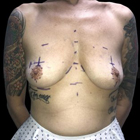Overly large breasts can be the cause of a variety of discomforts: from the emotional pain of feeling acutely self-conscious as strangers’ eyes are drawn to your chest and the frustration that clothes don’t fit well, to the physical pain of back, neck and shoulder ache.
Mr Maisam Fazel sees many women in his Berkshire breast reduction clinic who say – with feeling – big breasts are not always a blessing. What can he do for them, and what is involved? Understanding the potential risks and complications involved is essential before making any decision; Mr Fazel will discuss these during a consultation – and explain how such risks are mitigated.
1. General risks of surgery
All surgery carries an element of risk, including an unexpected reaction to the anaesthetic, excessive bleeding and developing a blood clot. It is therefore paramount that you choose a surgeon and clinic who are highly trained and experienced – and have an excellent safety record.
2. Scarring
When incisions are made, it is impossible to avoid any scarring at all but a skilled and experienced surgeon can produce fine scars and judicious aftercare can encourage them to heal into discreet lines, concealable by underwear.
During your Berkshire breast reduction consultation, Mr Fazel will describe in detail what scarring you should expect; the anchor technique, for example, requires a scar around the areola, one from the nipple to the inframammary crease, and one from the breastbone to the armpit along the crease. He will also explain what it takes to encourage healthy healing of breast reduction wounds and scars, including the deleterious effects of smoking.
3. Loss of nipple sensation
The nerves to the nipples may be damaged during your breast reduction resulting in altered sensation or nipples that don’t become erect. In many cases, sensation returns to normal within 3–6 months but in some cases the loss can be permanent.















